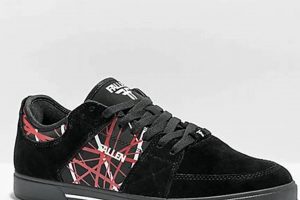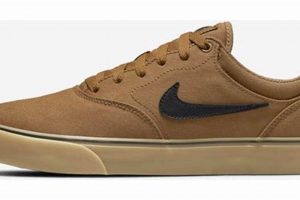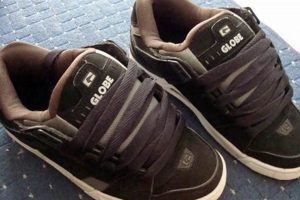Footwear designed for skateboarding, specifically models produced under the Converse CONS line, represents a segment of athletic shoes engineered to withstand the rigors of skateboarding. These shoes typically feature durable construction, reinforced stitching, and specialized outsoles designed for enhanced grip and board feel. Examples include the CONS CTAS Pro and CONS One Star Pro, both popular choices among skateboarders for their functionality and classic aesthetic.
The importance of skateboarding-specific footwear lies in its ability to protect the feet and ankles during high-impact activities. The reinforced materials and cushioning systems found in these shoes provide crucial support and impact absorption. Historically, while standard athletic shoes were initially used for skateboarding, the development of specialized models addressed the unique demands placed on footwear by the sport, leading to increased performance and reduced risk of injury. The evolution of these designs reflects an understanding of the interaction between the shoe and the skateboard, optimizing control and durability.
This understanding of specialized skate footwear leads to an examination of specific design features, material choices, and technological advancements that contribute to its overall performance and suitability for skateboarding. Further exploration will delve into the construction methodologies, testing protocols, and market positioning strategies associated with this class of athletic footwear.
Essential Considerations for Choosing Skateboarding Footwear
Selecting appropriate footwear is critical for both performance and safety in skateboarding. The following considerations should inform the choice of skate shoes.
Tip 1: Prioritize Durability: Skateboarding subjects shoes to significant abrasion. Look for models with reinforced stitching, particularly in high-wear areas such as the ollie patch and toe region. Suede or canvas uppers with rubber underlays offer increased resistance to tearing.
Tip 2: Evaluate Sole Construction: Vulcanized soles, commonly found in skate shoes, provide excellent board feel and grip. However, they may wear down more quickly than cupsole constructions. Consider the intended frequency and intensity of use when assessing sole durability.
Tip 3: Assess Ankle Support: High-top designs offer increased ankle support, which can be beneficial for beginners or individuals prone to ankle injuries. Low-top models provide greater freedom of movement but offer less protection.
Tip 4: Examine Cushioning Systems: Impact absorption is crucial for protecting the feet during landings. Look for shoes with enhanced cushioning in the heel and forefoot. Insoles with shock-absorbing properties can further mitigate impact forces.
Tip 5: Consider Board Feel: While cushioning is important, excessive padding can reduce board feel, hindering precise control. A balance between impact protection and board feel is essential for optimal performance.
Tip 6: Inspect Lacing Systems: Recessed or reinforced lacing systems can prevent lace breakage, a common issue in skateboarding. Consider models with lace protection or durable lace materials.
Tip 7: Evaluate Fit and Comfort: Proper fit is paramount for comfort and performance. Ensure the shoes are neither too tight nor too loose. Wear socks similar to those used when skateboarding during the fitting process.
Selecting skateboarding footwear requires a careful consideration of durability, support, board feel, and fit. Prioritizing these elements will enhance performance and minimize the risk of injury.
These guidelines provide a framework for selecting appropriate skateboarding footwear. Further research into specific models and technological advancements can further refine the selection process.
1. Durability
Durability is a critical attribute of skateboarding footwear, and it serves as a primary differentiator between standard athletic shoes and those designed specifically for skateboarding activities, such as Converse CONS skate shoes. The causal relationship between skateboarding and shoe wear is direct: the repetitive friction, impact, and abrasive forces generated during skateboarding rapidly degrade footwear not designed to withstand such stresses. Therefore, enhanced durability is not merely a desirable feature but a fundamental requirement for skate shoes.
Converse CONS skate shoes address the durability requirement through several design and material choices. Reinforced stitching, particularly in high-stress areas like the ollie patch and toe cap, mitigates premature wear and tear. The use of robust materials such as suede or canvas with rubber backing further enhances resistance to abrasion. For instance, the CONS CTAS Pro model often incorporates a rubber-backed canvas, providing increased protection against board contact compared to a standard canvas upper. The practical significance of this enhanced durability translates to a longer lifespan for the shoe, reducing the frequency of replacement and, consequently, the overall cost for the skateboarder.
The trade-off between durability and other factors, such as board feel and weight, presents a design challenge. Overly thick or rigid materials may enhance durability but can also reduce sensitivity and control on the board. The Converse CONS line attempts to balance these competing demands by strategically reinforcing critical areas while maintaining a relatively flexible sole and upper construction. While no shoe is indestructible, the emphasis on durability in CONS skate shoes aims to provide a reasonable lifespan for skateboarders who subject their footwear to considerable stress. The ongoing challenge lies in innovating materials and construction techniques to further enhance durability without compromising performance or comfort.
2. Board Feel
Board feel, in the context of skateboarding footwear, refers to the tactile sensitivity experienced by the skateboarder through their shoes, enabling them to perceive the subtle contours and movements of the board. This attribute is critical for maintaining control, executing tricks, and accurately gauging the board’s response. The design and construction of Converse CONS skate shoes directly influence the degree of board feel offered.
- Sole Construction and Thickness
The type and thickness of the sole significantly impact board feel. Converse CONS typically employ vulcanized soles, known for their flexibility and low profile. This construction allows the sole to conform closely to the shape of the skateboard, transmitting detailed sensory information to the foot. Thicker soles, while offering increased cushioning, often diminish board feel by creating a greater distance between the foot and the board. Therefore, CONS designs aim to balance cushioning with the need for tactile sensitivity.
- Outsole Pattern and Grip
The pattern on the outsole also influences board feel. A flatter, less aggressive pattern typically enhances board feel by maximizing the contact area between the shoe and the grip tape on the skateboard. Converse CONS outsoles often feature a relatively smooth pattern, facilitating precise adjustments and micro-movements. The rubber compound used in the outsole also contributes; softer compounds tend to offer more grip and board feel, while harder compounds prioritize durability.
- Upper Material and Flexibility
The upper material’s flexibility plays a role in overall board feel. A softer, more pliable upper allows the foot to flex and move more naturally, enhancing the sensation of board movement. Converse CONS shoes, frequently constructed from canvas or suede, offer a balance between durability and flexibility. Stiffer, more rigid uppers can restrict movement and reduce the sensitivity of the foot, thereby diminishing board feel.
- Insole Design and Cushioning
The insole, while primarily responsible for impact absorption, can also influence board feel. Thin insoles provide minimal cushioning but maximize board feel, while thicker, more heavily cushioned insoles reduce board feel. Converse CONS often incorporate relatively thin insoles to maintain a balance between impact protection and tactile sensitivity. The material and shape of the insole can also affect the foot’s ability to perceive the board’s contours.
The interplay of sole construction, outsole pattern, upper material, and insole design determines the level of board feel offered by Converse CONS skate shoes. While prioritizing durability and impact protection, these shoes also aim to provide sufficient tactile sensitivity, enabling skateboarders to maintain control and accurately respond to the nuances of the board’s movements. The ongoing evolution of skate shoe technology seeks to further refine this balance, optimizing both performance and comfort.
3. Impact Protection
Impact protection is a paramount consideration in the design and functionality of skateboarding footwear. Converse CONS skate shoes, while known for their classic aesthetic and board feel, also incorporate features aimed at mitigating the forces generated during skateboarding activities. Understanding these features is crucial for assessing the suitability of these shoes for various skateboarding styles and skill levels.
- Insole Technology
The insole serves as a primary line of defense against impact forces. Converse CONS skate shoes often utilize proprietary insole technologies, such as OrthoLite or similar materials, known for their cushioning and shock-absorbing properties. These insoles are designed to compress upon impact, dissipating energy and reducing the stress transmitted to the feet and joints. The thickness and density of the insole material directly correlate with its impact protection capabilities. For example, models intended for higher-impact skateboarding may feature thicker insoles with denser foam compositions.
- Midsole Construction
While not always a prominent feature in all Converse CONS models, the midsole, located between the insole and outsole, can contribute to impact protection. Some CONS variations incorporate a thin layer of EVA (ethylene-vinyl acetate) or similar cushioning material in the midsole to further absorb impact forces. The presence and type of midsole cushioning can significantly influence the overall ride feel and the level of protection offered. The absence of a substantial midsole in some models prioritizes board feel but may compromise impact protection.
- Outsole Design and Material
The outsole, while primarily responsible for grip and durability, indirectly contributes to impact protection. The rubber compound used in the outsole and the pattern of the tread can influence the distribution and absorption of impact forces. Thicker outsoles, particularly those with waffle or herringbone patterns, can provide a greater buffer between the foot and the ground. However, excessively thick outsoles can diminish board feel. The composition of the rubber can also affect its shock-absorbing properties; softer rubber compounds tend to provide more cushioning but may wear down more quickly.
- Collar and Tongue Padding
Padding in the collar and tongue regions of Converse CONS skate shoes offers additional protection and support, particularly during landings and maneuvers that place stress on the ankles and feet. Adequate padding in these areas can help to stabilize the foot and ankle, reducing the risk of injury. The density and thickness of the padding can vary between models, with some designs prioritizing cushioning and support while others emphasize a more streamlined fit.
The integration of insole technology, midsole construction, outsole design, and strategic padding contributes to the overall impact protection provided by Converse CONS skate shoes. While some models prioritize board feel and a low-profile design, others incorporate features designed to enhance impact absorption and support. The suitability of a particular CONS model for a given skateboarder depends on their individual needs, skateboarding style, and risk tolerance.
4. Grip
Grip, in the context of skateboarding footwear, represents the frictional force between the shoe’s outsole and the skateboard’s grip tape, facilitating board control and maneuverability. This interaction is pivotal for executing tricks, maintaining balance, and ensuring overall safety. The grip characteristics of Converse CONS skate shoes are therefore a critical factor in their performance.
- Outsole Rubber Compound
The type of rubber compound used in the outsole significantly impacts grip. Softer rubber compounds generally offer superior grip due to their increased coefficient of friction. Converse CONS shoes often utilize a proprietary rubber formula designed to balance grip with durability. The specific formulation influences the shoe’s ability to adhere to the grip tape under varying conditions, such as temperature and surface texture. For instance, a softer compound may excel in dry conditions but wear down more rapidly on abrasive surfaces.
- Outsole Tread Pattern
The design of the outsole tread pattern also contributes to grip performance. Patterns with closely spaced, multidirectional elements tend to maximize contact area and enhance grip. Converse CONS shoes often feature a classic herringbone or diamond pattern, providing reliable grip in various directions. The depth and spacing of the tread elements influence the shoe’s ability to maintain contact with the grip tape, particularly when the surface is uneven or contaminated with debris.
- Vulcanization Process
The vulcanization process, commonly used in the construction of Converse CONS skate shoes, affects the bond between the outsole and the upper, as well as the overall flexibility of the sole. Properly vulcanized soles provide a strong and durable bond, preventing separation and maintaining consistent grip performance over time. The degree of vulcanization can influence the rubber’s flexibility, with more flexible soles generally offering improved board feel and grip by conforming to the contours of the skateboard.
- Contact Area and Surface Texture
The overall contact area between the outsole and the grip tape is a crucial determinant of grip. Larger contact areas provide more surface friction, enhancing stability and control. The surface texture of the outsole also plays a role. Micro-textures, such as fine grooves or ridges, can increase friction and improve grip, particularly on smooth surfaces. The design of Converse CONS outsoles seeks to maximize contact area while maintaining a suitable level of durability and flexibility.
The grip characteristics of Converse CONS skate shoes are a product of the rubber compound, tread pattern, vulcanization process, and overall contact area. These elements work in concert to provide the necessary traction for skateboarding, balancing grip performance with durability and board feel. Understanding the interplay of these factors is crucial for selecting appropriate footwear for specific skateboarding styles and conditions.
5. Ankle Support
Ankle support within Converse CONS skate shoes represents a critical design element that directly affects both performance and injury prevention. Skateboarding, by its nature, involves dynamic movements and high-impact landings, placing significant stress on the ankles. Inadequate ankle support can lead to sprains, strains, and other related injuries. The Converse CONS line addresses this concern through varying levels of ankle support, typically determined by the shoe’s collar height and the presence of internal padding. The causal relationship is clear: increased ankle support reduces the likelihood of ankle injuries during skateboarding. For example, high-top CONS models offer greater stability than low-top versions, making them a preferred choice for skaters who prioritize ankle protection, especially those new to the sport or engaging in more aggressive maneuvers.
The practical significance of understanding ankle support in Converse CONS lies in selecting the appropriate shoe model for individual needs and skating style. Low-top designs offer greater freedom of movement and board feel, often favored by experienced skaters who prioritize agility and control. However, this comes at the cost of reduced ankle stability. Conversely, high-top models restrict ankle movement to a greater extent, providing enhanced support but potentially sacrificing some board feel. The presence and density of internal padding around the ankle also contribute to the level of support. Real-world examples demonstrate that skaters recovering from ankle injuries or those with a history of instability often benefit from the increased support offered by high-top CONS models with ample padding. This choice allows them to skate with greater confidence and reduces the risk of re-injury.
In summary, ankle support is a crucial component of Converse CONS skate shoes, directly impacting both safety and performance. The choice between high-top and low-top designs, along with the presence of internal padding, determines the level of support provided. Selecting the appropriate model based on individual needs, skating style, and injury history is essential for maximizing benefits and minimizing risks. Further advancements in ankle support technology may offer improved protection without compromising board feel, representing an ongoing area of development in skateboarding footwear.
6. Style
Style, in the realm of skateboarding footwear, represents a multifaceted attribute encompassing aesthetic design, brand identity, and cultural associations. Its relevance to Converse CONS skate shoes stems from the historical context of both the brand and the sport, influencing purchasing decisions and shaping the perception of the wearer.
- Classic Silhouette and Enduring Appeal
Converse CONS skate shoes often retain the iconic silhouette of classic Converse models, such as the Chuck Taylor All Star and the One Star. This deliberate design choice leverages the brand’s heritage and resonates with skaters who appreciate a timeless aesthetic. The enduring appeal of these silhouettes transcends fleeting trends, ensuring their continued relevance within skateboarding culture. The implications are that the shoes appeal to a wide range of skaters, from those who value tradition to those seeking a versatile and easily recognizable style.
- Colorways and Customization Options
The availability of diverse colorways allows skaters to express individual preferences and align their footwear with personal style. Converse CONS shoes are frequently released in both classic and limited-edition color palettes, catering to various tastes. Furthermore, the blank canvas nature of many Converse models encourages customization, enabling skaters to personalize their shoes through artwork, patches, or other modifications. Examples include collaborations with artists or skaters, resulting in unique and highly sought-after designs. This allows for further individuality and self expression.
- Brand Identity and Cultural Association
The Converse brand holds a significant position within skateboarding culture, having been adopted by skaters for decades. This association stems from the shoes’ durability, functionality, and widespread availability. The Converse CONS line reinforces this connection through collaborations with prominent skaters and sponsorships of skateboarding events. Wearing Converse CONS shoes often signifies an affiliation with a specific skateboarding subculture or aesthetic, influencing perceptions and shaping social dynamics within the skating community.
- Functionality as a Styling Element
While primarily designed for performance, certain functional features of Converse CONS skate shoes contribute to their overall style. Reinforced stitching, durable materials, and vulcanized soles, while serving practical purposes, also add a rugged and authentic aesthetic. The visible wear and tear accumulated through skateboarding can further enhance the style, reflecting the skater’s dedication and experience. This “worn-in” look is often valued within skateboarding culture, adding character and individuality to the shoes.
These facets collectively illustrate the integral role of style in the context of Converse CONS skate shoes. The convergence of classic design, customization options, brand identity, and functional features creates a product that not only performs effectively but also serves as a form of self-expression and cultural affiliation. Further exploration could examine the influence of specific collaborations or the evolution of Converse CONS style within different skateboarding subcultures, demonstrating the dynamism and complexity of this relationship.
Frequently Asked Questions
The following section addresses common inquiries regarding Converse CONS skate shoes, providing factual information to assist in informed decision-making.
Question 1: Are Converse CONS skate shoes suitable for all skateboarding styles?
Converse CONS skate shoes cater to a variety of skateboarding styles, but suitability depends on individual preferences and skill levels. Models with enhanced ankle support and impact protection may be preferable for vert or transition skating, while those prioritizing board feel may be more suitable for street skating. Consideration of individual needs is crucial.
Question 2: How does the durability of Converse CONS compare to other skate shoe brands?
The durability of Converse CONS skate shoes is generally considered competitive with other established skate shoe brands. Certain models feature reinforced stitching and durable materials to withstand the wear and tear of skateboarding. However, lifespan varies based on skating frequency, style, and the specific model chosen.
Question 3: What is the significance of “CONS” in the product name?
“CONS” designates the skateboarding-specific line within the Converse brand. These shoes are engineered with features tailored to the demands of skateboarding, such as enhanced durability, improved board feel, and impact protection, distinguishing them from standard Converse lifestyle models.
Question 4: Can Converse CONS skate shoes be used for purposes other than skateboarding?
While designed primarily for skateboarding, Converse CONS shoes can be worn for general casual wear. Their classic aesthetic and comfortable design make them suitable for everyday use. However, it is important to acknowledge that their skateboarding-specific features may not be fully utilized or appreciated in non-skateboarding contexts.
Question 5: How does the vulcanized sole construction affect the performance of Converse CONS skate shoes?
The vulcanized sole construction of Converse CONS skate shoes provides excellent board feel and flexibility, allowing for precise control and responsiveness. However, vulcanized soles may wear down more quickly than cupsole constructions, potentially requiring more frequent replacement depending on usage intensity.
Question 6: Are Converse CONS skate shoes suitable for individuals with foot or ankle problems?
Individuals with pre-existing foot or ankle conditions should consult with a medical professional before using Converse CONS skate shoes for skateboarding. The shoes’ level of support and cushioning may not be adequate for individuals with specific orthopedic needs. Customized insoles or orthotics may be necessary to enhance comfort and stability.
In summary, Converse CONS skate shoes represent a viable option for skateboarders seeking a blend of classic style and functional performance. Careful consideration of individual needs and preferences is essential for selecting the appropriate model.
The following section transitions to practical tips for extending the lifespan of skateboarding footwear.
Conclusion
This exploration has elucidated key characteristics of Converse CONS skate shoes, focusing on design elements such as durability, board feel, impact protection, grip, ankle support, and style. The analysis reveals a balance between classic aesthetics and functional performance, positioning these shoes as a relevant option within the skateboarding footwear market. The features discussed are instrumental in enhancing the skateboarding experience, and the importance of choosing the correct footwear is underscored by its direct link to safety and performance.
The informed selection and responsible utilization of skateboarding footwear are essential for both aspiring and experienced skateboarders. The continual advancements in materials and design suggest a promising trajectory for future innovations within the industry. Further investigation into individual models and technologies remains a valuable pursuit for any serious skateboarding participant.


![Best Cheap Skate Shoes Mens: [Brand Name] & More! Learn to Surf & Skate: A Beginner's Step-by-Step Guide Best Cheap Skate Shoes Mens: [Brand Name] & More! | Learn to Surf & Skate: A Beginner's Step-by-Step Guide](https://universitysurfandskate.com/wp-content/uploads/2025/10/th-981-300x200.jpg)




